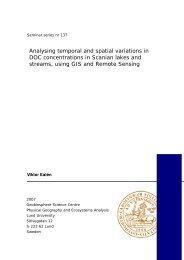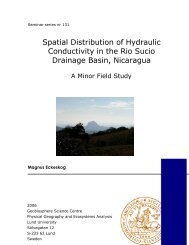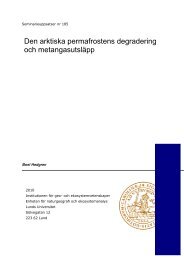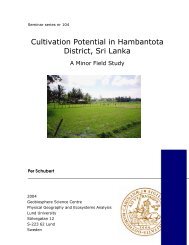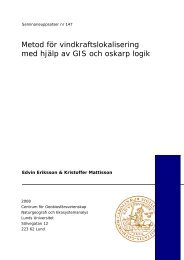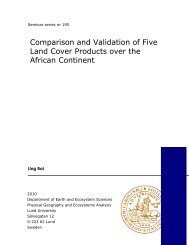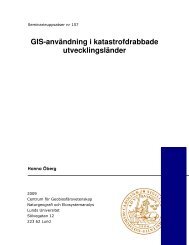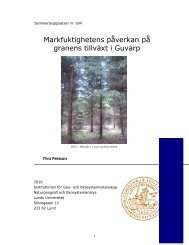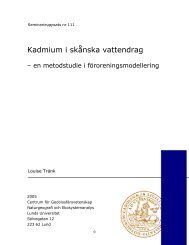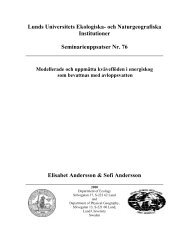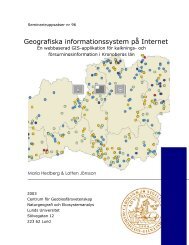Finding Potential Sites for Small-Scale Hydro Power in Uganda: a ...
Finding Potential Sites for Small-Scale Hydro Power in Uganda: a ...
Finding Potential Sites for Small-Scale Hydro Power in Uganda: a ...
Create successful ePaper yourself
Turn your PDF publications into a flip-book with our unique Google optimized e-Paper software.
7 ConclusionsThe objectives of this study were to identify potential sites <strong>for</strong> small-scale hydropower <strong>in</strong>our study area, to develop a method <strong>for</strong> localization of potential small-scale hydropowersites <strong>in</strong> the develop<strong>in</strong>g world and to <strong>in</strong>vestigate the rural energy situation <strong>in</strong> <strong>Uganda</strong>. Byreach<strong>in</strong>g these objectives we can now answer the questions <strong>in</strong> the <strong>in</strong>troduction:o The result from our algorithm was 250 potential sites, of which we <strong>in</strong>tended toevaluate 25. Because of time limitations, we were only able to evaluate 14 sites,which resulted <strong>in</strong> three approved potential sites, where the potential electricaloutput ranged between 1.9 and 48.4 kW.o By develop<strong>in</strong>g our method we have realized that the use of a GIS is a swift andprecise way to identify potential sites <strong>for</strong> small-scale hydropower stations.o The importance of data quality is of weight <strong>in</strong> the matter of contour data, buterrors can relatively easy be detected and edited. The quality of watercourse<strong>in</strong>put data is of major importance, s<strong>in</strong>ce imprecise digitalization and classificationerrors would result <strong>in</strong> a totally mislead<strong>in</strong>g output. We there<strong>for</strong>e recommend toour method with available watercourse data <strong>in</strong> comb<strong>in</strong>ation with a thoroughfield survey <strong>in</strong> order to ensure which sites that really have a potential <strong>for</strong> smallscalehydropower.o The result from our <strong>in</strong>terviews po<strong>in</strong>t to an exist<strong>in</strong>g need <strong>for</strong> electricity <strong>in</strong> ourstudy area, which we consider to be a general op<strong>in</strong>ion <strong>in</strong> rural areas of <strong>Uganda</strong>.Energy and electricity plays an important role <strong>in</strong> economic growth and ruraldevelopment. The most evident impacts of modern energy services are that theystimulate <strong>in</strong>come-generat<strong>in</strong>g bus<strong>in</strong>esses at local level, improve education, genderequality and health.o The governmental action <strong>in</strong> <strong>Uganda</strong> made to assist rural electrification consistsof the Rural Electrification Strategy and Plan. The ma<strong>in</strong> approach is to extendthe exist<strong>in</strong>g grid, implement m<strong>in</strong>i-grids and photovoltaic units, but there is also apossibility <strong>for</strong> private <strong>in</strong>itiators to receive subsidies from the Rural ElectrificationFund.In conclusion, our method <strong>for</strong> locat<strong>in</strong>g potential sites <strong>for</strong> small-scale hydropower is swiftand precise, presupposed reliable <strong>in</strong>put data is available. If there is a need <strong>for</strong> electricity65



